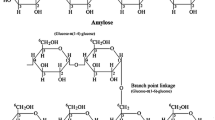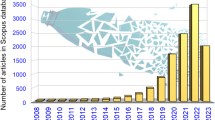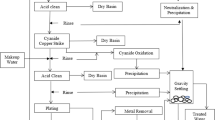Abstract
In this paper, composite coagulants (PFS, PFSC05, PFSC1 and PFSC5), prepared by mixing polyferric sulfate (PFS) and cationic polyelectrolyte (CP) coagulants with different weight percent (W p) of CP (W p = 0%, 0.5%, 1% and 5%, respectively), were adopted to treat cyanide-containing wastewater. PFSC5 exhibited superior coagulation performances at optimal conditions: the removal of total cyanide (TCN) and chemical oxygen demand (COD) was 95%–97% and 50%–55%, respectively. The effects of CP on the properties and structure of flocs were investigated by laser diffraction instrument and small-angle laser light scattering (SALLS), respectively. The results show that the flocs of PFSC5 have higher growth rate, higher strength factor and lower recovery factor than other flocs. They are also much denser and more uniform owing to the higher fractal dimension (Df) and less microflocs (10–100 μm). Furthermore, the dense structure of the PFSC5 flocs can be restored after shear and is more resistant to hydraulic conditions. Particularly, detailed morphology evolution of the flocs was in-situ detected by on-line particle imaging. Due to strong ionic strength in wastewater, the CP in PFSC5 plays a significant role of adsorption, while the main mechanism of CP is electrostatic patch aggregation during the PFSC05 systems.
Similar content being viewed by others
References
Patil YB, Paknikar KM. Development of a process for biodetoxification of metal cyanides from wastewater. Process Biochem, 2000, 35: 1139–1151
Integrated wastewater discharge standard. National Standard of People’s Republic of China (In Chinese). GB 18918-2002
Dash RR, Gaur A, Balomajumderb C. Cyanide in industrial wastewaters and its removal: A review on biotreatment. J Hazard Mater, 2009, 163: 1–11
Kang Q. Residual color profiles of simulated reactive dyes wastewater in flocculation processes by polydiallyldimethyl ammonium chloride. Sep Purif Technol, 2007, 57: 356–365
Shen ZS, Han BB, Wickramasinghe SR. Cyanide removal from industrial praziquantel wastewater using integrated coagulation-gas-filled membrane absorption. Desalination, 2006, 195: 40–50
Lai P, Zhao HZ, Wang C, Ni JR. Advanced treatment of coking wastewater by coagulation and zero-valent iron processes. J Hazard Mater, 2007, 147: 232–239
Park DH, Kim YM, Lee DS, Park JM. Chemical treatment for treating cyanides-containing effluent from biological cokes wastewater treatment process. Chem Eng J, 2008, 143: 141–146
Flaten TP. Aluminium as a risk factor in Alzheimer’s disease, with emphasis on drinking water. Brain Res Bull, 2001, 55: 187–196
Bell-Ajy K, Abbaszadegan M, Ibrahim E, Verges D, LeChevallier M. Conventional and optimized coagulation for NOM removal. J Am Water Works Assoc, 2000, 92: 44–58
Jiang JQ, Graham NJD. Coagulation of upland coloured water with polyferric sulphate compared to conventional coagulants. J Water Supply, 1996, 45: 143–154
Kleefish JL. Cyanide Removal From Coke Oven Wash Waters. US Patent, 5260632, 1992-11-03
Yablonsky A. Groundwater Total Cyanide Treatment Method. US Patent, 491495, 1997-07-15
Mabire F, Audebert R, Quivoron C. Flocculation properties of some water-soluble cationic copolymers toward silica suspensions: A semiquantitative interpretation of the role of molecular weight and cationicity through a “patchwork” model. J Colloid Interface Sci, 1984, 97: 120–136
Graham NJD. Orthokinetic flocculation rates for amorphous silica microspheres with cationic polyelectrolytes. Colloid Surface, 1981, 3: 61–77
Gregory J. Flocculation by polymers and polyelectrolyte. In: Tadros TF, Eds. Solid/Liquid Dispersions. London: Academic Press, 1987. 163–181
Kage H, Matsuno Y, Higashitani K. Flocculation of kaolin suspension with cationic polymer. Can J Chem Eng, 1988, 66: 728–734
Zhou Y, Franks GV. Flocculation mechanism induced by cationic polymers investigated by light scattering. Langmuir, 2006, 22: 6775–6786
Wei JC, Gao BY, Yue QY, Wang Y, Li WW, Zhu XB. Comparison of coagulation behavior and floc structure characteristic of different polyferric-cationic polymer dual-coagulants in humic acid solution. Water Res, 2009, 43: 724–732
Moussas PA, Zouboulis AI. A new inorganic-organic composite coagulant, consisting of polyferric sulphate (PFS) and polyacrylamide (PAA). Water Res, 2009, 43: 3511–3524
Shi BY, Tang HX. Preparation and characterisation of organic polymer modified composite polyaluminium chloride. J Environ Sci, 2006, 18: 214–220
Chau KW. Investigation on effects of aggregate structure in water and wastewater treatment. Water Sci Technol, 2004, 50: 119–124
Jarvis P, Jefferson B, Parsons SA. Breakage, regrowth, and fractal nature of natural organic matter flocs. Environ Sci Technol, 2005, 39: 2307–2314
American Public Health Association (APHA), American Water Works Association (AWWA). Standard Methods for the Examination of Water and Wastewater. 20th ed. Washington, 1998
Yukselen MA, Gregory J. The reversibility of floc breakage. Int J Miner Process, 2004, 73: 251–259
Guan J, Waite TD, Amal R. Rapid structure characterization of bacterial aggregates. Environ Sci Technol, 1998, 32: 3735–3742
Hart J, Zhu Y, Pirard E. Particle size and shape characterization-Current technology and practice. In: Christidis G, Eds. Advanced in the Characterization of Industrial Minerals. Lecture Notes 9, European Mineralogical Union. 2010
Leroy S, Dislaire G, Bastin D, Pirard E. Optical analysis of particle size and chromite liberation from pulp samples of a UG2 ore regrinding circuit. Miner Eng, 2011, 24: 1340–1347
Boller M, Blaser S. Particles under stress. Water Sci Technol, 1998, 37: 9–29
Thomas DN, Judd SJ, Fawcett N. Flocculation modeling: A review. Water Res, 1999, 33: 1579–1592
Parker DS, Kaufman WJ, Jenkins D. Floc breakup in turbulent flocculation proeesses. In: Journal of the Sanitary Engineering Division: Proceeding of the American Soeiety of Civil Engineers SAI. 1972. 79–99
Baehe DH, Johnson C, MeGilligan JF. A conceptual view of floc structure in the sweep floe domain. J San Eng Div, 1997, 36: 49–56
Aguilar MI, Saez J, Llorens M, Soler A, Ortuno JF. Microscopic observation of particle reduction in slaughterhouse wastewater by coagulation-flocculation using ferric sulphate as coagulant and different coagulant aids. Water Res, 2006, 37: 2233–2241
Yu JF, Wang DS, Ge XP, Yan MQ, Yang M. Flocculation of kaolin particles by two typical polyelectrolytes: A comparative study on the kinetics and floc structures. Colloid Surface A, 2006, 290: 288–294
Sun CZ, Yue QY, Gao BY, Cao BC, Mu RM, Zhang ZB. Synthesis and floc properties of polymeric ferric aluminum chloride-polydimethyl diallylammonium chloride coagulant in coagulating humic acid kaolin synthetic water. Chem Eng J, 2012, 185–186: 29–34
Wei JC, Gao BY, Yue QY, Wang Y. Effect of dosing method on color removal performance and flocculation dynamics of polyferric-organic polymer dual-coagulant in synthetic dyeing solution. Chem Eng J, 2009, 151: 176–182
Waite TD. Measurement and implications of floc structure in water and wastewater treatment. Colloid Surf A, 1999, 151: 27–41
Bushell GC, Yan YD, Woodfield D, Raper J, Amal R. On techniques for the measurement of the mass fractal dimension of aggregates. Adv Colloid Interface Sci, 2002, 95: 1–50
Selomulya C, Amal R, Bushell G, Waite TD. Evidence of shear rate dependence on restructuring and break-up of latex aggregates. J Colloid Interface Sci, 2001, 236: 67–77
Spicer PT, Pratsinis SE, Raper J, Amal R, Bushell G, Meesters G. The reversibility of floc breakage. Powder Technol, 1998, 97: 26–34
Oosawa F. Polyelectrolytes. New York: Marcel Dekker, 1971
Eriksson L, Alm B. Effects of polyelectrolyte characteristics and flocculation conditions on fine particle floc properties. Nordic Pulp Pap Res J, 1993, 8: 153–159
Claesson PM, Dahlgren MAG, Eriksson L. Forces between polyelectrolyte-coated surfaces: Relations between surface interaction and floc properties. Colloid Surface A, 1994, 93: 293–303
Adachi Y, Aoki K. Restructuring of small flocs of polystyrene latex with polyelectrolyte. Colloid Surface A, 2009, 342: 24–29
Wei JC, Gao BY, Yue QY, Wang Y. Strength and regrowth properties of polyferric-polymer dual-coagulant flocs in surface water treatment. J Hazard Mater, 2010, 175: 949–954
Author information
Authors and Affiliations
Corresponding authors
Electronic supplementary material
Rights and permissions
About this article
Cite this article
Shen, J., Zhao, H., Xie, Y. et al. Coagulation behaviors and in-situ flocs characteristics of composite coagulants in cyanide-containing wastewater: Role of cationic polyelectrolyte. Sci. China Chem. 56, 1765–1774 (2013). https://doi.org/10.1007/s11426-013-4957-y
Received:
Accepted:
Published:
Issue Date:
DOI: https://doi.org/10.1007/s11426-013-4957-y




